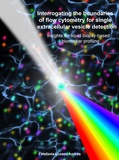Interrogating the boundaries of flow cytometry for single extracellular vesicle detection
Insights for liquid biopsy-based biomarker profiling

Lozano, Estefanía
- Promoter:
- Prof. dr. M.H.M. (Marca) Wauben
- Co-promoter:
- Dr. G.J.A. (Ger) Arkesteijn
- Research group:
- Wauben
- Date:
- May 30, 2023
- Time:
- 10:15 h
Summary
Extracellular vesicles (EVs) are cell-derived multicomponent messengers that participate in diverse intercellular communication processes regulating immune responses, cell survival and proliferation. However, EVs also play a role in disease processes like cancer. Since EVs contain biological information that reflects the status of the cell of origin, they might be used in liquid biopsies as disease biomarkers. The detection and characterization of EVs is a fundamental step towards EV-based biomarker profiling of pathological processes and is complicated due to their small size, heterogeneity and complex composition. Therefore, technological solutions that allow high throughput detection and analysis of single EVs are of utmost importance. Flow cytometry (FCM) is a promising technology for this purpose. However, traditional flow cytometers, designed for cells, lack the sensitivity for the detection of nano-sized EVs, whose signals are typically below or at the detection limit of conventional instruments.
In my PhD thesis I explored the limits of flow cytometry of single EVs, provide guidance for reproducible and robust EV FCM and address the challenges of EV analysis in body fluids. First, we developed and characterized a reference material for EV research. Next, we focused on high-sensitivity FCM for the detection of EVs and I present a reporting framework developed by the ISEV-ISAC-ISTH EV Flow cytometry workgroup to increase reproducibility of results. Since fluorescence calibration of EV signals is of importance for inter-instrument and inter-lab comparisons, we provide insights into the utilization of current calibrators and show that intrinsic variations related to these calibrators compromise accurate calibration of EV signals. In addition to the fluorescence, light scatter signals also contain valuable information that it is often lost within the background noise. By using an open-architecture flow cytometer, we optimized the configuration by combining differently sized hardware components to improve light scatter-based EV detection by reducing optical background signals. Lastly, we applied these technological advancements in the field of high-sensitivity FCM to investigate interactions between biological particles, namely EVs and lipoprotein particles (LPPs), which are known to co-isolate. Liquid biopsy EV-based biomarker profiling is complicated because LPPs in blood outnumber EVs by orders of magnitude and have biophysical overlapping properties with EVs, including size and density. We here demonstrate by high-sensitivity FCM, in combination with orthogonal methods; i.e., Rayleigh and Raman scattering and cryo-electron microscopy, that EV-LPP complexes can be formed and can impact EV-analysis in blood. Overall, the findings presented in my thesis contribute to the development of robust liquid biopsy EV biomarker profiling by FCM and shed light on the complexity of single EV analysis in body fluids, which will ultimately help to a successful clinical translation of EVs as disease biomarkers.